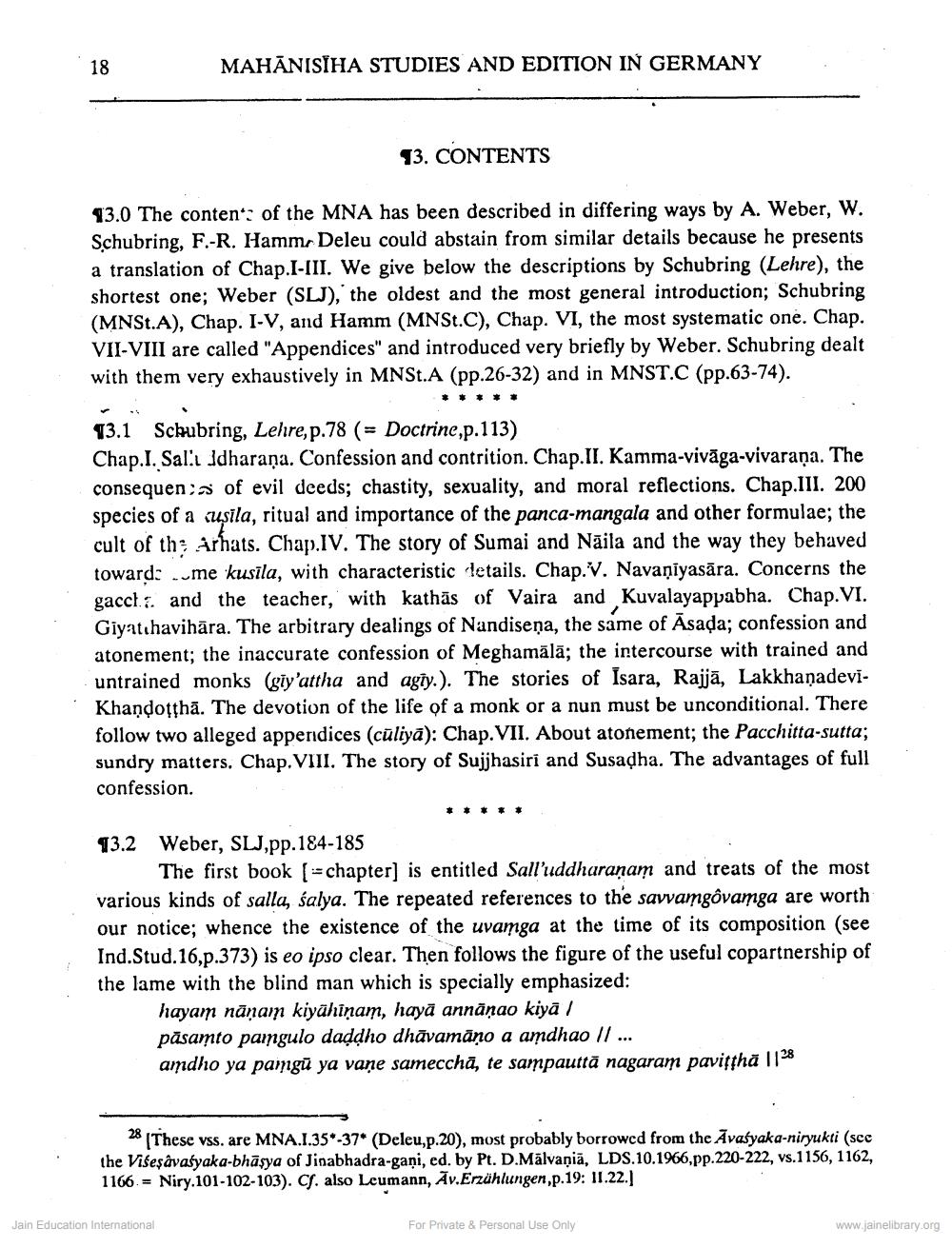________________
MAHĀNISIHA STUDIES AND EDITION IN GERMANY
13. CONTENTS
13.0 The conten: of the MNA has been described in differing ways by A. Weber, W. Schubring, F.-R. Hamm. Deleu could abstain from similar details because he presents a translation of Chap.I-III. We give below the descriptions by Schubring (Lehre), the shortest one; Weber (SLJ), the oldest and the most general introduction; Schubring (MNSt.A), Chap. I-V, and Hamm (MNSt.C), Chap. VI, the most systematic one. Chap. VII-VIII are called "Appendices" and introduced very briefly by Weber. Schubring dealt with them very exhaustively in MNSt.A (pp.26-32) and in MNST.C (pp.63-74).
13.1 Schubring, Lehre,p.78 (= Doctrine,p.113) Chap. I. Salli dharaņa. Confession and contrition. Chap. II. Kamma-vivāga-vivarana. The consequen; of evil deeds; chastity, sexuality, and moral reflections. Chap.Ill. 200 species of a usila, ritual and importance of the panca-mangala and other formulae; the cult of th; irhats. Chap.IV. The story of Sumai and Nāila and the way they behaved towards .ume kusila, with characteristic details. Chap.V. Navaniyasāra. Concerns the gacch.. and the teacher, with kathās of Vaira and Kuvalayappabha. Chap. VI. Giyatıhavihāra. The arbitrary dealings of Nandisena, the same of Āsada; confession and atonement; the inaccurate confession of Meghamälā; the intercourse with trained and untrained monks (giy'attha and agiy.). The stories of Isara, Rajjā, LakkhanadeviKhandotthā. The devotion of the life of a monk or a nun must be unconditional. There follow two alleged appendices (cūliyā): Chap. VII. About atonement; the Pacchitta-sutta; sundry matters. Chap. VIII. The story of Sujjhasiri and Susadha. The advantages of full confession.
13.2 Weber, SLJ,pp. 184-185
The first book (=chapter) is entitled Sall'uddharaṇam and treats of the most various kinds of salla, salya. The repeated references to the savvamgôvamga are worth our notice; whence the existence of the uvamga at the time of its composition (see Ind.Stud. 16,p.373) is eo ipso clear. Then follows the figure of the useful copartnership of the lame with the blind man which is specially emphasized:
hayam nāņain kiyāhīņam, hayā annāņao kiya / päsamto pamgulo daddho dhāvamāņo a amdhao ll ... amdho ya pamgū ya vaạe samecchā, te sampauttā nagaram pavitthā 1128
28 These vss. are MNA.1.35*-37* (Deleu,p.20), most probably borrowed from the Āvasyaka-niryukti (see the Visesavasyaka-bhāsya of Jinabhadra-gani, ed. by Pt. D.Mālvaņiā, LDS.10.1966, pp.220-222, vs.1156, 1162, 1166. = Niry.101-102-103). CJ. also Leumann, Av.Erzählungen,p.19: 11.22.
Jain Education International
For Private & Personal Use Only
www.jainelibrary.org




